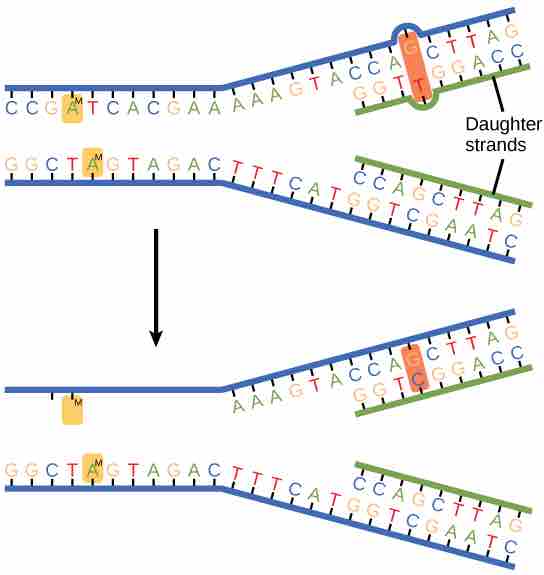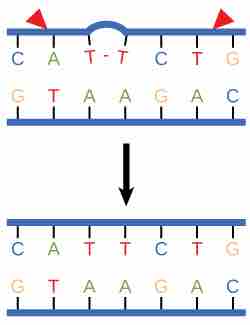Errors during Replication
DNA replication is a highly accurate process, but mistakes can occasionally occur as when a DNA polymerase inserts a wrong base. Uncorrected mistakes may sometimes lead to serious consequences, such as cancer. Repair mechanisms can correct the mistakes, but in rare cases mistakes are not corrected, leading to mutations; in other cases, repair enzymes are themselves mutated or defective.
Most of the mistakes during DNA replication are promptly corrected by DNA polymerase which proofreads the base that has just been added . In proofreading, the DNA pol reads the newly-added base before adding the next one so a correction can be made. The polymerase checks whether the newly-added base has paired correctly with the base in the template strand. If it is the correct base, the next nucleotide is added. If an incorrect base has been added, the enzyme makes a cut at the phosphodiester bond and releases the incorrect nucleotide. This is performed by the exonuclease action of DNA pol III. Once the incorrect nucleotide has been removed, a new one will be added again.

DNA polymerase proofreading
Proofreading by DNA polymerase corrects errors during replication.
Some errors are not corrected during replication, but are instead corrected after replication is completed; this type of repair is known as mismatch repair . The enzymes recognize the incorrectly-added nucleotide and excise it; this is then replaced by the correct base. If this remains uncorrected, it may lead to more permanent damage. How do mismatch repair enzymes recognize which of the two bases is the incorrect one? In E. coli, after replication, the nitrogenous base adenine acquires a methyl group; the parental DNA strand will have methyl groups, whereas the newly-synthesized strand lacks them. Thus, DNA polymerase is able to remove the incorrectly-incorporated bases from the newly-synthesized, non-methylated strand. In eukaryotes, the mechanism is not very well understood, but it is believed to involve recognition of unsealed nicks in the new strand, as well as a short-term continuing association of some of the replication proteins with the new daughter strand after replication has been completed.

Mismatch Repair
In mismatch repair, the incorrectly-added base is detected after replication. The mismatch-repair proteins detect this base and remove it from the newly-synthesized strand by nuclease action. The gap is now filled with the correctly-paired base.
In another type of repair mechanism, nucleotide excision repair, enzymes replace incorrect bases by making a cut on both the 3' and 5' ends of the incorrect base . The segment of DNA is removed and replaced with the correctly-paired nucleotides by the action of DNA pol. Once the bases are filled in, the remaining gap is sealed with a phosphodiester linkage catalyzed by DNA ligase . This repair mechanism is often employed when UV exposure causes the formation of pyrimidine dimers.
DNA Ligase I Repairing Chromosomal Damage
DNA damage, due to environmental factors and normal metabolic processes inside the cell, occurs at a rate of 1,000 to 1,000,000 molecular lesions per cell per day. A special enzyme, DNA ligase (shown here in color), encircles the double helix to repair a broken strand of DNA. DNA ligase is responsible for repairing the millions of DNA breaks generated during the normal course of a cell's life. Without molecules that can mend such breaks, cells can malfunction, die, or become cancerous. DNA ligases catalyse the crucial step of joining breaks in duplex DNA during DNA repair, replication and recombination, and require either Adenosine triphosphate (ATP) or Nicotinamide adenine dinucleotide (NAD+) as a cofactor.

Nucleotide Excision Repairs
Nucleotide excision repairs thymine dimers. When exposed to UV, thymines lying adjacent to each other can form thymine dimers. In normal cells, they are excised and replaced.
DNA Damage and Mutations
Errors during DNA replication are not the only reason why mutations arise in DNA. Mutations, variations in the nucleotide sequence of a genome, can also occur because of damage to DNA. Such mutations may be of two types: induced or spontaneous. Induced mutations are those that result from an exposure to chemicals, UV rays, X-rays, or some other environmental agent. Spontaneous mutations occur without any exposure to any environmental agent; they are a result of natural reactions taking place within the body.
Mutations may have a wide range of effects. Some mutations are not expressed; these are known as silent mutations. Point mutations are those mutations that affect a single base pair. The most common nucleotide mutations are substitutions, in which one base is replaced by another. These can be of two types: transitions or transversions. Transition substitution refers to a purine or pyrimidine being replaced by a base of the same kind; for example, a purine such as adenine may be replaced by the purine guanine. Transversion substitution refers to a purine being replaced by a pyrimidine or vice versa; for example, cytosine, a pyrimidine, is replaced by adenine, a purine. Mutations can also be the result of the addition of a base, known as an insertion, or the removal of a base, known as a deletion. Sometimes a piece of DNA from one chromosome may get translocated to another chromosome or to another region of the same chromosome.